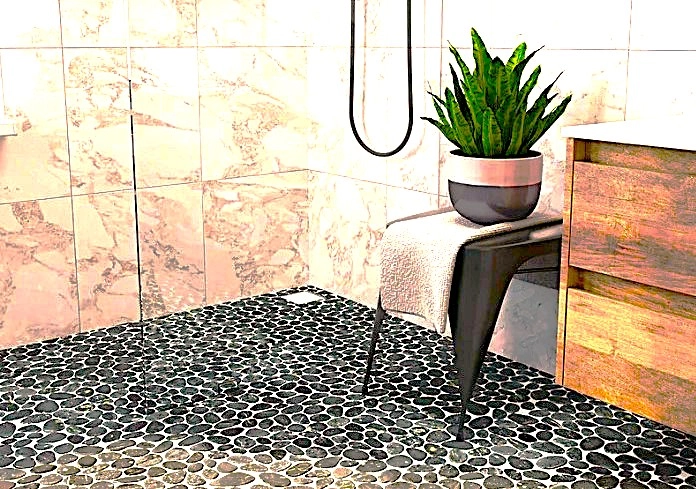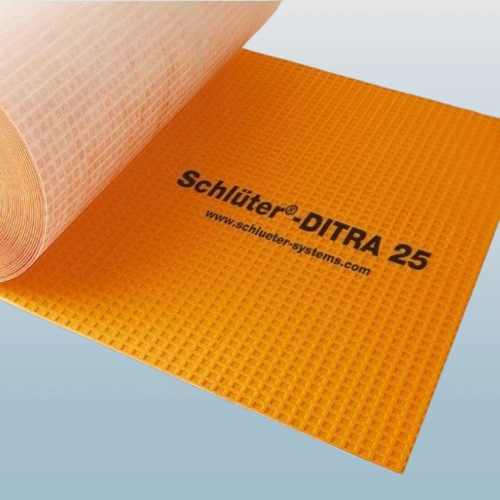Pebble Shower Floor Turning White?

Pebble floors are becoming more popular among homeowners who are sick of the plain and uninteresting tile patterns found in shower floors.
Although this design has numerous advantages, it has a serious flaw in that the surface ultimately turns white.
Since many homeowners have had this problem, I made the decision to write this guide, which will examine the reasons behind whitened pebble shower floors and the best solutions.
Why Does a White Pebble Shower Floor Occur?
This issue has multiple causes, which includ
- 1. Efflorescence
The main cause of the white haze on the majority of pebble shower floors is this. You’re undoubtedly curious about how efflorescence occurs in pebble stones.
The science, however, is really simple. Water-soluble salts that are present within the pebbles eventually rise to the top and crystallize to produce a white, powdered material.
It is more challenging to manage efflorescence on pebble shower floors if a sealant was used afterwards. A sealer covers the white haze that crystallizes on the pebble floor by forming a protective coating over it.
The solution is straightforward for dealing with efflorescence on a pebble shower floor. All you need is some vinegar and a basic pebble stone cleaner.
The white substance should go away right away if you pour one of these two over the pebble shower floor.
To gain direct access to the pebble stone’s surface, any sealant that may be on the floor needs to be removed. A sealant stripper is available at the hardware shop closest to you.
- 2. Buildup of Shampoo, Soap, and Other Toiletries
The bathroom or shower is the room in your house that is most frequently exposed to a variety of goods.
These items, which range from soaps to hair treatments, might leave a white residue on your pebble shower floor after drying. You’re more prone to experience this issue if you don’t clean your bathroom on a regular basis.
The solution is to first determine whether you have a buildup of shampoo and soap. If the pebble floor becomes greasy or smeary after you pour water on it, the white haze is likely dried-up soap.
Clean your bathroom thoroughly to get rid of it. Dry soap or shampoo scum should be readily removed from your pebble floor with a brush and some warm water.
Making it a practice to clean your bathroom on a regular basis is also advised. You should be able to steer clear of this issue going forward.
- 3. Hard Water Areas
You may be dealing with hard water spots if your pebble shower floor has turned white and you live in a hard water location. When hard water evaporates into moisture, the minerals it contains frequently leave behind white streaks.
You’ll also notice a powdery accumulation on the faucet’s tip or any other aluminum or steel surface in your bathroom if hard water is the cause of your problems.
The Fix: Hard water stains that are turning your pebble shower floor white can be removed, despite their stubbornness.
A scrubbing brush and vinegar solution ought should do the trick. Additionally, hard water stains can be avoided by keeping your bathroom clean on a regular basis.
- 4. Mold
A pebble shower floor is subject to water all the time, which can cause moisture to seep through the grout lines and become trapped.
This fosters an atmosphere that is favorable for the growth of mold. A white or gray area appears on the surface of your pebble shower floor as the mold grows.
The Fix: Use vinegar, bleach, or any other potent cleaning solution to get rid of the mold from your pebble shower floor.
Apply it to the white areas and use a brush to scrub. Make sure you have on goggles, a mask, and gloves. You should never breathe in or come into direct touch with mold since it poses a health risk.
- 5. Slow Wear
The purpose of a pebble shower floor was short-lived. The stones will get whiter and begin to lose their color over time.
Your pebble shower floor will weather as a result of exposure to foot traffic, soap, and bathroom supplies.
In contrast to the aforementioned reasons, you will notice a pattern, particularly in high-traffic areas, if your pebble shower floor is going white due to wear. Additionally, the surface won’t have any powdery material on it.
The Solution: There aren’t many ways to restore worn-out pebble shower flooring. Scheduling a replacement is the best course of action.
The worn-out and outdated pebble shower floor can be removed and replaced by a skilled professional. If you intend to sell the house, I would suggest doing this since it will increase its market value.
Is It Safe to Use a Strong Cleaner on a Whitened Pebble Shower Floor?
When most individuals see that their pebble shower floor has turned white, their first instinct is to use the strongest cleanser they can find. Although it’s alluring, I wouldn’t advise it.
Strong cleansers have the potential to etch certain pebble stones, particularly those made of calcium.
Therefore, attempting to remove mildew, efflorescence, or hard water stains that are turning your pebble shower floor white may cause further harm. I mostly suggested using vinegar when I listed the preceding cures.
On tile or pebble stone, vinegar is a little kinder than most commercial cleaners, which are loaded with harsh chemicals. Although it won’t etch the pebble stones, it works well to remove white materials from your shower floor.
Strong cleansers should not be used on your pebble shower floor unless absolutely required.
How Can a Pebble Shower Floor Avoid Whitening?
Pebble shower floors require a lot of upkeep, to be honest. They aren’t everyone’s cup of tea because of this. The following steps should be taken if you wish to keep your pebble shower floor’s original color:
- At least once a week, give your bathroom a thorough cleaning.Everything can be removed with a thorough wash, including soap scum, efflorescence, and hard water stains.
agenda time for bathroom cleaning in your weekly agenda. This helps eliminate bacteria in your bathroom in addition to keeping your floor from becoming white.
- After taking a shower, squeegee the floor.People who live in places with hard water are more affected by this. The amount of water that is left behind is reduced when you squeegee the floor after taking a shower.
Consequently, you won’t have to cope with hard water stains that eventually turn white. This method is also useful for keeping mold from growing in your shower.
- Make an effort to maintain low moisture levels.I am aware that a restroom cannot be completely dry. If you reduce the quantity of moisture in your bathroom, though, it may be worthwhile.
To encourage airflow, this can be accomplished by opening the doors or windows. Mold development and efflorescence can be avoided by lowering moisture levels.
Are There Any Other Issues With Pebble Shower Floors That You Should Know About?
There are a few other issues you should be mindful of in addition to pebble shower flooring going white. Among them are
- Pebble stone and tile do not drain well due to their irregular design. Poor drainage is typically the result of some water becoming trapped between the grout lines.
- A pebble shower floor may be uncomfortable to walk on if it is not fitted properly. The tiler has to make sure the pebbles are positioned uniformly during the installation process.
- Compared to other shower floor types, pebbles deteriorate more quickly. It’s not an investment for the long run.

